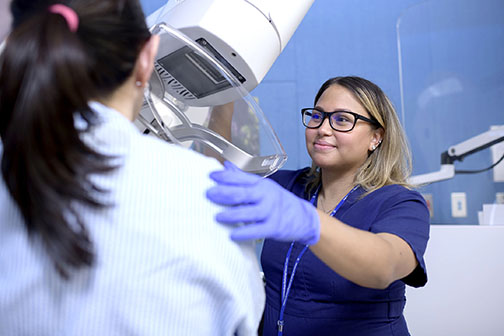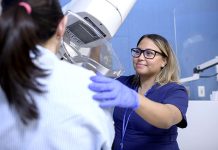
By Sunayana Prabhu
Being diagnosed with breast cancer is overwhelming.
But, during the monthlong National Breast Cancer Awareness campaign which started Oct. 1, health care institutions, nonprofits, survivor groups and breast cancer specialists are adamant that early detection can be life-saving, especially for high-risk individuals.
Breast cancer begins with mutations in genes and proteins that cause uncontrollable growth of cells in the breast tissue. According to the Mayo Clinic, after skin cancer, breast cancer is the most commonly diagnosed cancer in women in the United States.
High risk for breast cancer can be attributed to family history, radiation exposure before age 30, gene mutations that increase risk, postmenopausal obesity or lifestyle choices such as smoking and alcohol consumption, among others.
Signs and symptoms of breast cancer may include a breast lump or thickened area of skin around the surrounding tissue, flattened or inward-facing nipples and changes in breast size, shape or skin color. Breast skin could be peeling, scaling, crusting or look dimpled, resembling an orange peel.
The disease manifests in several types and subtypes determined by different factors, including the specific location where it first starts to grow, how it grows or spreads and how it behaves. The American Cancer Society has grouped breast cancer into several types based on these factors.
Proactive Monitoring
Health care professionals urge the use of screenings and other early detection methods that can be vital to catching the disease in its most treatable stages.
Maura Galligan, a 51-year-old resident of Shrewsbury, has faced this battle almost her entire life. At just 15 years old she lost her mother to the disease and has since made it her mission to stay one step ahead of breast cancer through early detection and proactive monitoring.
Galligan’s mother was first diagnosed with breast cancer in 1981 at the age of 46. She underwent a lumpectomy and chemotherapy, but the cancer returned a few years later, spreading to her lymph nodes, brain, liver and bones. Sadly, her mother died in 1988. “From a young age, I knew that breast health was really important,” Galligan said.
Following her mother’s passing, Galligan began getting annual mammograms at the age of 27, a full decade earlier than the recommended screening age for women without a family history. In 2007, Galligan joined RISE (Risk Assessment, Imaging, Surveillance and Education), a comprehensive screening program at Memorial Sloan Kettering Cancer Center in Middletown designed particularly for people at increased risk for breast cancer.
As part of the program, Galligan undergoes mammograms, MRIs and ultrasounds twice a year. “Screening is the critical piece of surviving cancer,” Galligan said. Her vigilance extends beyond regular screenings. When she experienced a lump after breastfeeding her first child, she promptly sought medical attention and said she was relieved to learn it was a benign condition. She also underwent genetic testing in 2010 and again in 2018 to check for any genetic markers that could increase her risk of breast cancer. “Knowledge is power,” Galligan said and genetic testing and screening are ways that you can help
“Cancer isn’t curable, (but) it is absolutely treatable when it’s detected early,” she said.
For those with a family history of breast cancer, having open discussions with doctors about screening schedules and risk-reduction strategies is crucial.
Detection and Treatment
on the RISE
Several health care institutions now offer comprehensive cancer screening and treatment programs that allow high-risk individuals to receive early diagnosis and tailored care.
Joanne Cregg, head nurse of the RISE program at MSK, echoed the early-detection sentiment. RISE was developed to provide specialized care for high-risk patients, many of whom may feel overwhelmed by such an assessment which can occur from the detection of gene mutations or, more significantly, having a first-degree relative with breast cancer.
She assesses each patient’s risk level using specialized tools and, based on the results, determines the appropriate mammogram, ultrasound, MRI and biopsy schedule.
She said the streamlined process is “an added reassurance” for anxious patients because it eliminates the time spent waiting for outside pathology results.
According to Cregg, patients with certain gene mutations start receiving MRIs at age 25; at age 30 those alternate with mammograms. Persons with a family history of breast cancer are referred for screening 10 years before the youngest family member’s diagnosis.
For routine screening mammograms, patients can visit any facility that performs the procedure. If an abnormality is detected, a biopsy may be recommended, which can be conducted by the radiology facility or a breast surgeon.
“We know breast cancer is 100% curable if we can catch it early,” Cregg said.
Treatment modalities for breast cancer depend on the subtype of cancer. Hormone-positive cancers require different therapies than aggressive HER2-positive or triple-negative cancers.
“Ultimately, surgery does need to be done to remove the tumor,” said Serena Wong, M.D., a medical oncologist specializing in breast cancer at MSK, either by lumpectomy or mastectomy, but that is “often not enough” and additional treatments are added to get rid of any potential microscopic cells that could possibly lead to a recurrence of breast cancer.
Radiation can sometimes be added after the surgery to decrease the chance of recurrence; chemotherapy or a combination of chemotherapy and immune therapy, HER2 target therapy or estrogen blockers may be warranted. Targeted therapy administered either before or after surgery, in combination with chemotherapy, “can dramatically reduce the risk of recurrence in the future,” Wong said.
“It is a very individualized treatment, depending on the woman herself as a person as well as her specific cancer,” Wong said.
Because of modern therapy options, the outlook can be good even for aggressive types of cancer, she added.
While the side effects of treatment can vary, Wong emphasized the importance of managing both short-term and long-term consequences. Chemotherapy can cause fatigue, hair loss, nausea and immune suppression, while estrogen blockers may lead to menopausal-like symptoms such as hot flashes, mood changes and body aches.
Wong also emphasized the critical need to continue raising awareness about how often breast cancer affects men; Wong said 1% of men develop breast cancer and those with a gene mutation are at an increased risk.
“I’ve had male patients who noticed a lump but never thought in a million years that men could get breast cancer, leading to delayed medical attention,” she said.
While mammograms are the standard screening tool for women, Wong explained they are not routinely recommended for men due to the low breast tissue that makes performing the test challenging. However, she does consider regular mammograms for male patients who have previously been treated for the disease. Wong urged families with a history of the BRCA mutation to “educate their male relatives, because they can develop it, too, and also, they can pass on the BRCA gene to their daughters and sons.”
Diagnosis and Treatment,
Then What?
After completing treatment, patients enter the survivorship phase, which involves continued surveillance for potential recurrence and the management of long-term side effects.
Besides regular follow-ups with medical teams, health care professionals also encourage survivors to attend support groups to address any psychological and emotional aspects of survivorship, as anxiety and fears of recurrence are common.
Despite the challenges, Wong is optimistic about the progress made in breast cancer treatment, particularly in the development of less toxic and more effective therapies. She stressed the continued need for reliable information from reputable sources, such as the American Cancer Society and Susan G. Komen Foundation, to ensure patients receive accurate and personalized guidance.
The article originally appeared in the October 3 – 9, 2024 print edition of The Two River Times.















